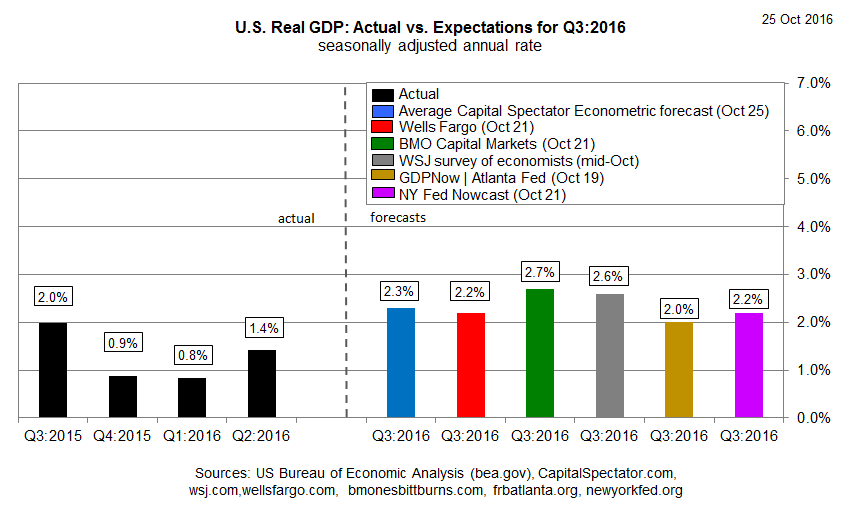The US economy is on track to expand at the fastest rate in more than a year in the third quarter, according to projections for this Friday’s “advance” GDP report from the Bureau of Economic Analysis. A range of estimates anticipate that quarterly output will top 2% (seasonally adjusted annual rate). If the prediction holds up, output is set to break free of the sluggish pace of roughly 1.0% that’s prevailed in each of the previous three quarters.
The average Q3 prediction in The Wall Street Journal’s October survey of economists is 2.6%, nearly twice as strong as Q2’s 1.4% pace. The forecast marks the strongest quarterly rise since 2015’s Q2.
Econometric estimates from two regional Fed banks, however, anticipate moderately lower but-still-encouraging gains in Friday’s release. The Atlanta Fed’s Q3 GDPNow model is projecting a 2.0% increase (as of Oct. 19); the New York Fed’s nowcast is a bit firmer at 2.2% (Oct. 21).

But some analysts see storm clouds gathering, in part because the Fed appears to be laying the groundwork for a year-end rate hike. “We are seeing a serious deterioration [in liquidity] on a monthly basis,” Michael Howell at CrossBorder Capital said last week. As a result, “we think the US is heading for recession by the Spring of 2017. It is absolutely bonkers for the Fed to even think about raising rates right now,” he opined via The Telegraph.
Misguided or not, it’s clear that the monetary trend is skewing negative these days. As reported by The Capital Spectator last week, real (inflation-adjusted) M0 money supply contracted by nearly 9% in September–the biggest year-over-year slide in nearly seven decades.
But while trouble may be brewing, recession risk remains low at the moment, based on the data published through September. As discussed in last week’s review of macro risk, the probability is virtually nil that the NBER, the official arbiter of the US business cycle, will declare September as the start of a new recession. Near-term projections through next month also reflect low business-cycle risk, and Friday’s GDP report is expected to reaffirm that view.














Leave A Comment